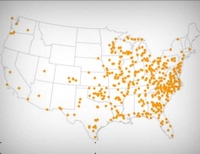California bill to end prison-based gerrymandering awaits the Governor’s signature
Prison Policy Initiative urges Governor Brown to sign California's bill to end prison-based gerrymandering.
by Aleks Kajstura, September 8, 2011
California’s movement to end prison-based gerrymandering is in the home stretch. Yesterday, the Assembly passed the Senate’s amendments to AB 420, and the bill passed its last legislature hurtle. The bill will give the Citizens Redistricting Commission the data necessary to count incarcerated people at their home addresses. When Governor Brown signs AB 420 into law, California will join New York, Maryland, and Delaware in ensuring equality in representation for all residents.
I sent a letter in support of the bill to the Governor, urging him to sign it into law.
The bill will fix a longstanding conflict between Census Bureau practices and California law. Redistricting data provided by the Census Bureau does not count incarcerated people at their home address; rather it counts them at the location of a prison. This approach is incongruous with California law which specifies that incarceration does not change a person’s residence. The result is districts that are skewed by non-resident populations, diluting the voting strength of everyone who does not live near a prison.
We discovered that most California counties with large prisons have already taken steps to limiting the impact of prison populations on their County Supervisory Districts. These ten counties remove the prison population from their redistricting data. Solano County is one of the two counties that did not adjust the census data in redistricting last decade and as a result, every group of 9 people who actually live in District 4 (which contains the CSP Solano and California Medical Correctional Facility) were granted as much influence as 10 people in Solano’s other districts. This bill would make sure that no county’s districts are unintentionally distorted by prison populations as they were in Solano.





